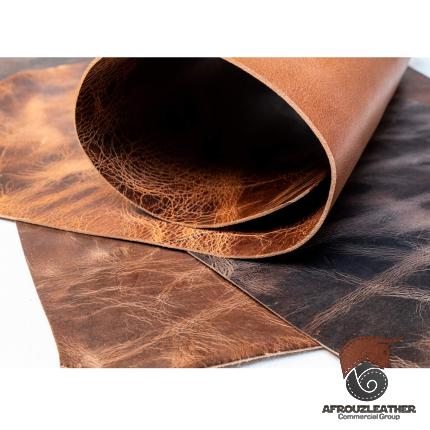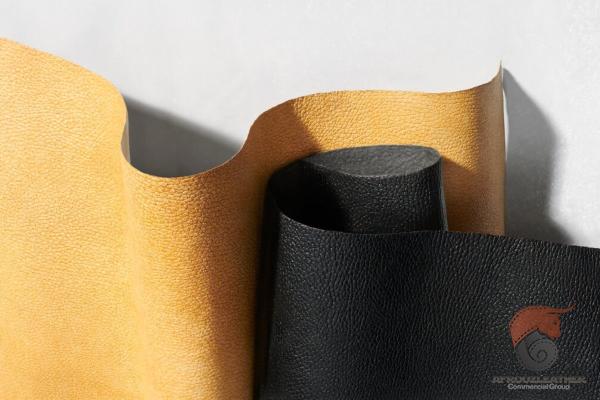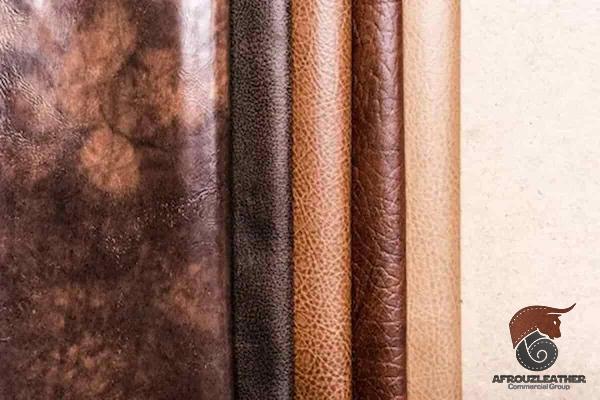Full grain leather and top grain leather are two types of leather commonly used in various applications, including furniture, bags, shoes, and accessories. While they are both derived from the same source, they differ in terms of quality and characteristics. Full grain leather is considered the highest quality of leather available. It is made from the top layer of the animal hide, which is the most durable and strongest part. Full grain leather retains the natural markings and texture of the animal hide, making each piece unique and individual. This type of leather is known for its durability, strength, and natural beauty. On the other hand, top grain leather is made by splitting the top layer of the animal hide and removing any imperfections or blemishes. This process reduces the overall thickness of the leather, making it less durable than full grain leather. However, top grain leather is still considered high-quality and is often used in upscale furniture and accessories. One of the main differences between full grain leather and top grain leather is the presence of natural markings and imperfections. Full grain leather retains these natural characteristics, such as scars, wrinkles, and grain patterns, giving it a more authentic and rustic appearance. Top grain leather, on the other hand, undergoes a process called sanding and buffing to remove any imperfections, resulting in a smoother and more uniform surface. In terms of durability, full grain leather outperforms top grain leather. The natural fibers and dense structure of full grain leather make it highly resistant to wear and tear, as well as moisture and stains. It ages well and develops a patina over time, enhancing its appearance and character. In contrast, top grain leather may be more susceptible to scratches and damage, although it still offers good durability compared to lower-quality leathers. Another factor to consider is the breathability of the leather.
leather
 Full grain leather allows for better air circulation, making it more comfortable to wear or sit on for extended periods. This breathability helps regulate body temperature and prevents the build-up of moisture. Top grain leather, while still breathable, may not provide the same level of ventilation. When it comes to cost, full grain leather is generally more expensive than top grain leather. The higher price reflects the superior quality and craftsmanship associated with full grain leather. However, the investment in full grain leather is often worth it, as it tends to last longer and age gracefully, making it a long-term investment. In conclusion, both full grain leather and top grain leather have their own unique characteristics and advantages. Full grain leather is known for its exceptional durability, natural beauty, and individuality. It offers superior strength and resilience, making it a preferred choice for products that require longevity and performance. Top grain leather, while slightly less durable and lacking the same natural markings, still offers good quality and a more uniform appearance. The choice between the two ultimately depends on personal preference, budget, and the specific application or purpose of the leather product. Full Grain Leather vs. Top Grain Leather: A Detailed Comparison 1. Introduction: – Briefly introduce full grain leather and top grain leather as two common types of leather used in various applications. – Mention that they differ in terms of quality, characteristics, and uses. – Highlight that full grain leather is considered the highest quality, while top grain leather is still of good quality. 2. Full Grain Leather: – Define full grain leather as the top layer of the animal hide, known for its durability and strength. – Explain that it retains the natural markings and texture of the hide, giving it a unique and rustic appearance. – Emphasize that full grain leather is highly durable, resistant to wear and tear, as well as moisture and stains. – Discuss that it ages well and develops a distinctive patina over time, enhancing its overall appeal and character. 3. Top Grain Leather: – Define top grain leather as leather made by splitting the top layer of the hide and removing imperfections. – Mention that this process results in a smoother and more uniform surface compared to full grain leather.
Full grain leather allows for better air circulation, making it more comfortable to wear or sit on for extended periods. This breathability helps regulate body temperature and prevents the build-up of moisture. Top grain leather, while still breathable, may not provide the same level of ventilation. When it comes to cost, full grain leather is generally more expensive than top grain leather. The higher price reflects the superior quality and craftsmanship associated with full grain leather. However, the investment in full grain leather is often worth it, as it tends to last longer and age gracefully, making it a long-term investment. In conclusion, both full grain leather and top grain leather have their own unique characteristics and advantages. Full grain leather is known for its exceptional durability, natural beauty, and individuality. It offers superior strength and resilience, making it a preferred choice for products that require longevity and performance. Top grain leather, while slightly less durable and lacking the same natural markings, still offers good quality and a more uniform appearance. The choice between the two ultimately depends on personal preference, budget, and the specific application or purpose of the leather product. Full Grain Leather vs. Top Grain Leather: A Detailed Comparison 1. Introduction: – Briefly introduce full grain leather and top grain leather as two common types of leather used in various applications. – Mention that they differ in terms of quality, characteristics, and uses. – Highlight that full grain leather is considered the highest quality, while top grain leather is still of good quality. 2. Full Grain Leather: – Define full grain leather as the top layer of the animal hide, known for its durability and strength. – Explain that it retains the natural markings and texture of the hide, giving it a unique and rustic appearance. – Emphasize that full grain leather is highly durable, resistant to wear and tear, as well as moisture and stains. – Discuss that it ages well and develops a distinctive patina over time, enhancing its overall appeal and character. 3. Top Grain Leather: – Define top grain leather as leather made by splitting the top layer of the hide and removing imperfections. – Mention that this process results in a smoother and more uniform surface compared to full grain leather.
Specifications of leather
 – Explain that top grain leather is still considered high-quality and commonly used in upscale furniture and accessories. – Note that it may be slightly less durable than full grain leather and more susceptible to scratches and damage. 4. Appearance and Character: – Compare the appearance of full grain leather and top grain leather. – Highlight that full grain leather showcases natural markings, such as scars, wrinkles, and grain patterns, giving it a rustic and authentic look. – Note that top grain leather appears smoother and more uniform due to the removal of imperfections. – Explain that the choice between the two is subjective and depends on the desired aesthetic. 5. Durability and Strength: – Discuss the durability and strength of full grain leather. – Explain that the natural fibers and dense structure of full grain leather make it highly resistant to wear and tear. – Mention that it can endure heavy usage and retain its shape and quality over time. – Compare this to top grain leather, which may be less durable but still offers good longevity compared to lower-quality leathers. 6. Comfort and Breathability: – Discuss the comfort and breathability of full grain leather. – Explain that its natural attributes allow for better air circulation, making it more comfortable to wear or sit on for extended periods. – Note that it helps regulate body temperature and prevents the build-up of moisture. – Mention that top grain leather, while still breathable, may not provide the same level of ventilation as full grain leather. 7. Aging Process and Patina: – Explain the aging process and patina development of full grain leather. – Highlight that full grain leather ages gracefully and develops a unique patina over time.
– Explain that top grain leather is still considered high-quality and commonly used in upscale furniture and accessories. – Note that it may be slightly less durable than full grain leather and more susceptible to scratches and damage. 4. Appearance and Character: – Compare the appearance of full grain leather and top grain leather. – Highlight that full grain leather showcases natural markings, such as scars, wrinkles, and grain patterns, giving it a rustic and authentic look. – Note that top grain leather appears smoother and more uniform due to the removal of imperfections. – Explain that the choice between the two is subjective and depends on the desired aesthetic. 5. Durability and Strength: – Discuss the durability and strength of full grain leather. – Explain that the natural fibers and dense structure of full grain leather make it highly resistant to wear and tear. – Mention that it can endure heavy usage and retain its shape and quality over time. – Compare this to top grain leather, which may be less durable but still offers good longevity compared to lower-quality leathers. 6. Comfort and Breathability: – Discuss the comfort and breathability of full grain leather. – Explain that its natural attributes allow for better air circulation, making it more comfortable to wear or sit on for extended periods. – Note that it helps regulate body temperature and prevents the build-up of moisture. – Mention that top grain leather, while still breathable, may not provide the same level of ventilation as full grain leather. 7. Aging Process and Patina: – Explain the aging process and patina development of full grain leather. – Highlight that full grain leather ages gracefully and develops a unique patina over time.
buy leather
 – Describe how the patina adds character and depth to the leather, making it even more desirable. – Note that top grain leather may also develop a patina but to a lesser extent. 8. Price and Investment: – Discuss the cost differences between full grain leather and top grain leather. – Highlight that full grain leather is generally more expensive due to its superior quality and craftsmanship. – Explain that the investment in full grain leather is often worth it, as it tends to last longer and age beautifully. – Mention that the higher price may be justified for long-term durability and value. 9. Uses and Applications: – Provide examples of products where full grain leather is commonly used, such as high-end furniture, luxury bags, and shoes. – Discuss how full grain leather’s durability and natural beauty make it suitable for products that require longevity and performance. – Mention that top grain leather is also used in similar applications but may be more commonly found in mid-range furniture and accessories. 10. Conclusion: – Summarize the key points discussed in the article. – Emphasize that both full grain leather and top grain leather have their own unique characteristics and advantages. – Reiterate that the choice between the two ultimately depends on personal preference, budget, and the specific application or purpose of the leather product.
– Describe how the patina adds character and depth to the leather, making it even more desirable. – Note that top grain leather may also develop a patina but to a lesser extent. 8. Price and Investment: – Discuss the cost differences between full grain leather and top grain leather. – Highlight that full grain leather is generally more expensive due to its superior quality and craftsmanship. – Explain that the investment in full grain leather is often worth it, as it tends to last longer and age beautifully. – Mention that the higher price may be justified for long-term durability and value. 9. Uses and Applications: – Provide examples of products where full grain leather is commonly used, such as high-end furniture, luxury bags, and shoes. – Discuss how full grain leather’s durability and natural beauty make it suitable for products that require longevity and performance. – Mention that top grain leather is also used in similar applications but may be more commonly found in mid-range furniture and accessories. 10. Conclusion: – Summarize the key points discussed in the article. – Emphasize that both full grain leather and top grain leather have their own unique characteristics and advantages. – Reiterate that the choice between the two ultimately depends on personal preference, budget, and the specific application or purpose of the leather product.

Your comment submitted.